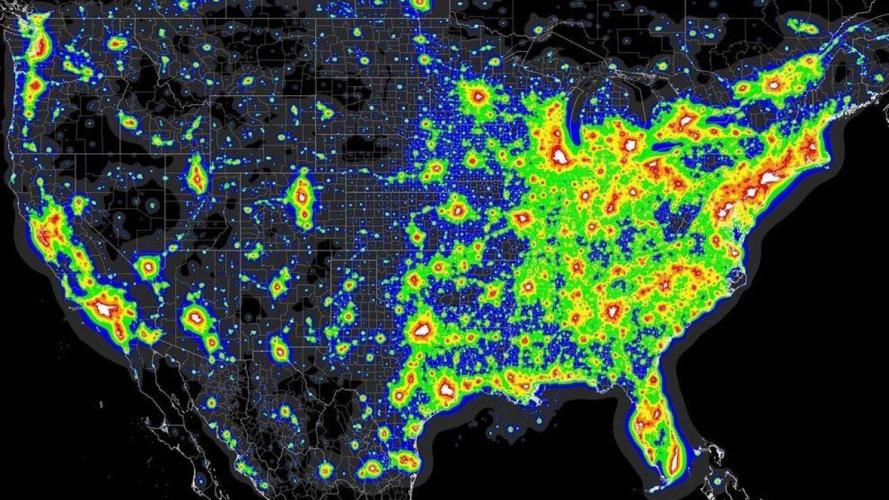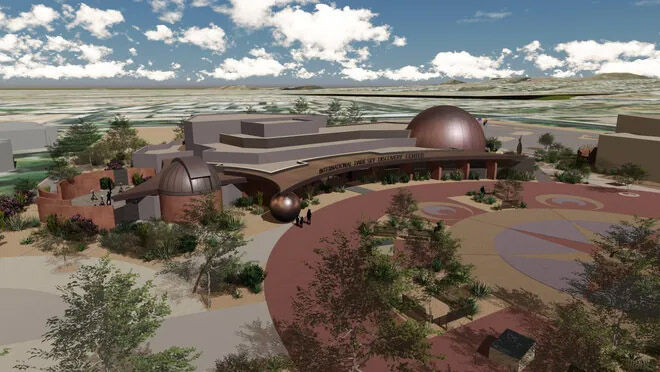When you go outside and look up at the night sky, can you see many stars overhead? At least 2,500 stars should be visible, but only a few can be seen by most Americans because of light pollution. DarkSky says that only 17% of the world has good nighttime visibility of the sky, and only 20% of Americans can see the Milky Way because of light pollution.
DarkSky International is an organization that works to preserve visibility of our night skies. Founded in 2001 in Tucson, DarkSky International is a nonprofit organization that promotes the use of low lighting in communities, parks, wildlife reserves, sanctuaries, and other locations throughout the world. There are 226 DarkSky certified locations presently, with more added each month.
DarkSky’s definition of light pollution is “man-made alterations of outdoor light levels from those occurring naturally”. In other words, light pollution is created by too many artificial lights shining at night. This is called night glow, and it can be seen from outer space.
DarkSky International educates the public about ways to decrease light pollution and encourages the reduction of light pollution by awarding special certificates to locations meeting specific criteria for nighttime lighting. Certified locations earn a spot on DarkSky’s website map. (darksky.org).
To earn DarkSky International certification, five requirements must be met.
• Restrict upward lighting
• Avoid glare from outdoor lights
• Avoid over-lighting the area
• Use dimmed lights or controlled lights that turn on and off at designated times
• Use warm colored light bulbs
DarkSky Week is the fourth week in April and is an opportunity for the public to learn more about the need to lower light pollution. DarkSky International works to educate the public about the harmful effects of light pollution on nocturnal animals. Light pollution hampers their ability to feed, reproduce and complete nighttime activities. From bats and moths to owls and sea turtles, many animals need darkness to survive.
70% of birds are migratory during fall and spring and most use the stars and moon to navigate. Birds that migrate at night can be driven off course by city lights. Some birds will circle endlessly among the lights and use up their energy so they cannot complete their migration. Others fly into lighted windows and are killed. DarkSky estimates 100 million birds are killed each year flying into windows and buildings at night.
Nocturnal hunters, like bats and owls, have difficulty catching their prey if light pollution prevents them from being hidden. Even fireflies are affected by outdoor lights which interfere with them seeing each other’s flashes for mating and communicating. Moths will circle around porch lights until they die. In Florida, sea turtle hatchlings can be disoriented by beachfront lights and often crawl toward the lights instead of crawling toward the moon and the ocean.
Arizona, to date, has the most DarkSky certified locations of any state. Arizona’s latest park certified is Saguaro National Park, near Tucson. The first DarkSky city, certified in 2001, was Flagstaff. Presently, NamibRand Nature Reserve is the only DarkSky reserve in Africa. It is one of the darkest spots on Earth and covers 772 square miles of plains, sand dunes, and mountains. Scotland, Ireland, England and Iceland are just a few of the countries with DarkSky certified locations.
Fountain Hills, Tubac and Sedona are certified DarkSky cities or communities. Grand Canyon Natl. Park, Kartchner Caverns State Park, Petrified Forest Natl. Park, and Sunset Crater Volcano Natl. Park are a few of the parks in Arizona certified by DarkSky.
Located in Fountain Hills, the International Dark Sky Discovery Center is under construction and will feature a Dark Sky Observatory, Hyperspace Planetarium, Inspiration Theater, Night Sky Exhibit Hall and Einstein Exploration Station. The center’s mission is to promote education, research, dark sky preservation and astrotourism. This 23,000 square foot facility will provide the public with a myriad of activities to learn more about the universe. Students will have the opportunity to learn about astronomy, and university astronomy students can conduct research using the Dark Sky Observatory.
Dr. Jeffrey Hall, former director of Lowell Observatory in Flagstaff, stated, “Dark skies are critical to Arizona’s multibillion-dollar astronomy industry, and we appreciate the efforts in Fountain Hills to maintain and promote dark skies in the Phoenix area and statewide.”
Residents often move to Fountain Hills because of its dark skies. Their local astronomy club has over 600 people on its mailing list, with star gazing parties held regularly. A founding member of the club donated three telescopes to the Fountain Hills Library, which led to a national award for the library. Hopefully, other Arizona communities will be inspired to become DarkSky certified. Preserving visibility of our night skies is important for our present and future generations.
Karen Bowen is a Master Gardener. Contact her at Facebook page, Yuma Desert Gardener, with your gardening questions.
















